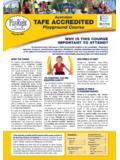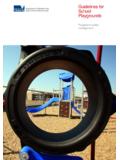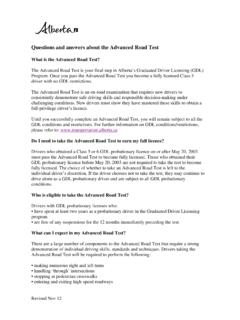Transcription of Title slide with an image - Down Syndrome Victoria
1 Education Writing an ILP/IEP for a student with an Intellectual Disability Australian Policies Disability Discrimination Act 1992 The Federal Disability Discrimination Act 1992 ( ) provides protection for everyone in australia against discrimination based on disability . Disability Standards for Education 2005 - The Standards give students and prospective students with disabilities the right to education and training opportunities on the same basis as students without a disability. Adjustments are outlined in the Standards. These could form part of your IEP. Types of adjustment Adjustments will vary depending on the student s disability, but could include: modifying educational premises, for example providing ramps, modifying toilets and ensuring that classes are in rooms accessible to the student modifying or providing equipment, for example, enlarging computer screens, or providing specific computer software or an audio loop system changing assessment procedures, for example, allowing for alternative examination methods, such as oral exams, or allowing additional time for someone else to write an exam for the student.
2 Changing course delivery, for example, providing study notes or research materials in different formats. 3 Information & Communication It is important to communicate to all staff working with the student the reasonable adjustments that the student requires and any other relevant information about the student Summarise/list all reasonable adjustments required in the classroom that the teachers can implement. Update regularly Adjustments should be discussed at SSG meetings Maintain good documentation 4 AusVELS Diversity of Learners For other students, teachers will need to make appropriate adjustments to the complexity of the curriculum content, focusing instruction on content different to that taught to others in their age group. It follows that adjustments will also need to be made to how the student s progress is monitored, assessed and reported. For a small percentage of students with disabilities, their learning will be well below the AusVELS Foundation standards.
3 Most of these students have a significant intellectual disability. Towards Foundation Level AusVELS provides this cohort of students with access to curriculum content and standards that enables students to move toward the learning described at Foundation level. 5 AsVELS Diversity of Learners AusVELS Diversity of Learners For AusVELS English, Mathematics, Science and History, the Towards Foundation Level AusVELS materials are integrated directly into the AusVELS curriculum and are referred to as Levels A to D . These materials include learning area-specific level descriptions, content descriptions and elaborations, achievement standards and scope and sequence charts. 6 AusVELS Diversity of Learners 7 Individual Educational Planning Department of Education and Training: Programme for Students with Disabilities Guidelines 2015: Links to AusVELS Curriculum landing page 8 Why have an IEP?
4 The development of an IEP is essential for addressing the needs of students who require additional support or an alternative or modified program, environment or curriculum Ensures the school fulfills their obligations in terms of departmental requirements and accountability Supports the school and classroom teacher in developing a meaningful teaching and learning program for individual students Promotes a collaborative process that has all team members involved working towards agreed goals and interventions Assists schools to determine required resources Provides a vehicle for sharing information 9 10 Individual Educational Planning Format of the IEP / ILP (see handouts) DET Outline of IEPs DET Outline and IEP template link 11 Educational Goals Goals should be set that: are meaningful; are realistic and achievable; are measurable describe the expected learning outcomes for a student describe the student s present levels of academic achievement and functional performance measure and report student progress 12 Educational Goals Long term Intermediate Short term Entry skill level Outcome targets Actual performance Assessment Evaluation IEP 13 Student Name Member of SSG School Grade Nature of additional need Date of plan Date of review Student s strengths Areas of additional support required IEP Template 14 Goals Barriers to achieving goal Strengths related to goal Strategies Evaluation Who Process Process is the way in which the content is presented to students.
5 It refers to how students make sense or understand the information ideas and skills being taught. Process can be differentiated by: Changing the pace. Changing the approach. Adjusting scaffolding. Some possible products Map Diagram Sculpture Discussion Demonstration Poem Play Dance Campaign Quiz Show Banner Brochure Debate Flow Chart Puppet Show Tour Timeline Lecture Editorial Painting Costume Catalogue Dialogue Newspaper Scrapbook Questionnaire Flag Graph Advertisement Book List Research Project TV Show Song Film Collection Trial Machine Mural Recipe Test Biography Review Puzzle Model Toy Article Diary Poster Magazine Computer Program Photographs Terrarium Petition Prototype Speech Cartoon Invention Some general strategies to support students with difficulties in your classroom that could be included in an IEP.
6 Brainstorm ideas Activate prior knowledge Familiarise with content pre-teach vocabulary and subject specific words Set purposes for reading Give questions first Retell information in student s our own words Talk about texts headings and graphics Adjustments in teaching Reduce the amount and complexity of materials and text. Break tasks into small achievable steps. Use human resources - peer tutoring, teacher aides, teachers, therapy services. Direct teach routines and expectations of behaviour. Celebrate successes. Use modelling and concrete examples. 18 Adjustments in assessment This has to be included in an IEP. How will you accommodate the student in terms of assessment and how will you measure their progress. Use technology to record students work; , digital photography, tape and video. Use team and peer assessment. Use picture sequencing and drawing demonstrations instead of text.
7 Use verbal presentation of concepts and skills. 19 Adjustments in assessment Assess using concrete and real life examples and environments. Make comparisons with personal progress, rather than the year level, where appropriate. Assess the important content and provide multiple opportunities for students to demonstrate what they know and what they can do with what they know. 20 Writing goals You need a current level of performance before you can write a clear and measurable goal Measurable means that you can count it or observe it. When tempted to write unmeasurable terms such as difficulty , weak , unmotivated , uncooperative , etc., ask yourself why it is you are writing or thinking that. What are you actually seeing this is the measurable element. To make something measurable you can specify a grade or age level performance, maybe through the use of AusVELS. You can also use a rating/counting scale 3 out of 4 times, 5 minutes out of every ten, etc.
8 21 Writing goals You can make the student s behaviour measurable by stating the facts of the situation when asked to work independently , in the playground and identify the results of the behaviour. A Functional Behaviour Assessment can be really useful here. 22 Writing goals You probably know most of what you need to know to make your goals measurable. Ask yourself questions like: What is the area of need for this student? How is this area of need related to this student s disability? How does this area of need impact (a) the student s progress in the general curriculum? (b) what does the student need for support in this area? What does the IEP team want this student to know or be able to do as a result of the IEP? Why can t she or he do it now? What is it about the student s disability that interferes with achieving this knowledge or skill? 23 Writing goals What is the actual (measurable) starting point for this knowledge or skill?
9 How will we know if the student can or succeeds at doing this? What will I see this student doing when he/she reaches this goal? How is this relevant to the student s learning needs? How can I measure this knowledge or skill? 24 Wording Billy tries very hard, but has difficulty completing assignments and turning them in on time. REWRITE: Billy is rarely off-task, yet she has failed to hand in .. assignments on time. Goal: Provided with modified assignments and adult assistance, Billy will complete assignments and submit them punctually 80% of the time Be clear and objective. This is a legal document. Against the advice of Penny Round, Mr. Smith has insisted that Billy continue with Further Maths. Send a copy home for the parents to sign and return and a copy for them to keep or get them to sign it at the end of the meeting. 25 Strategies to support students with Downs Syndrome /Intellectual Disability Make reading enjoyable Daily practice Start early Use a multi-sensory approach sand or Play-doh With a preference for visual over verbal when working with numbers use 6 not six Do not demand mastery before moving on to more advanced maths Use a strength based approach Teach up presumed competence presume that a child can learn 26 Strategies to support students with Downs Syndrome /Intellectual Disability Simultaneous prompting Constant or progressive time delay Task analysis the analysis of how a task is achieved Involve the family they know the child best & can share insights into likes, dislikes, strengths, weaknesses, past interventions, hopes, goals.
10 Strategies that have worked and to discuss what it is that the family prioritises Positive behaviour support respectful and positive interactions Self-determination develop the skills of choice making, problem solving, self-monitoring, decision making, goal setting and self-advocacy 27 Task analysis 28 Strategies to support students with Downs Syndrome /Intellectual Disability Find out what works as a motivator and use that Ensure the tasks are challenging but not out of the reach of the child This means you have to know your students well and proactively praise Learners with Down Syndrome have more difficulty with short term verbal memory and can have difficulties when communicating with the teacher that the task isn t understood. To work toward addressing this difficulty with requesting help, place a book or a game that the child likes in a container or on a high shelf help the child learn to ask for the book/game 29 30






